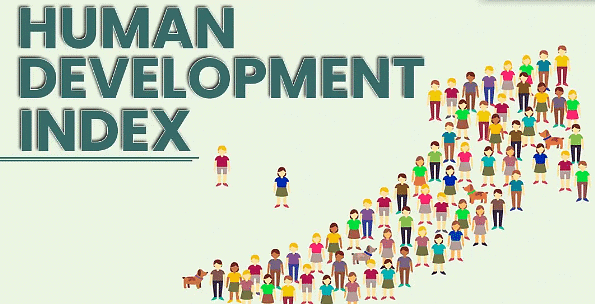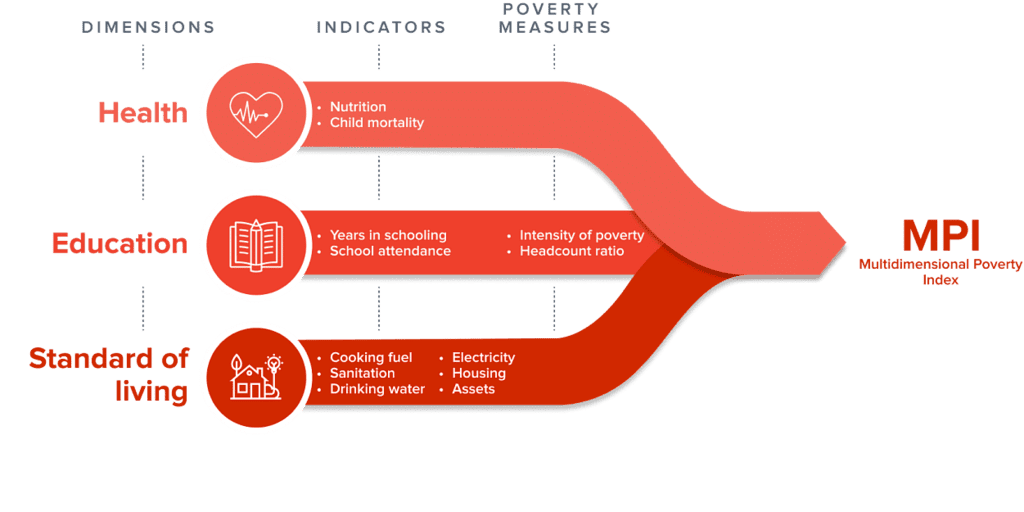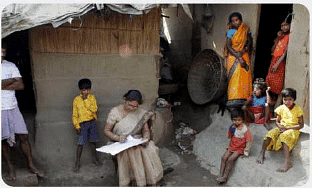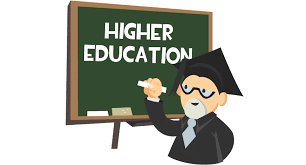Ramesh Singh Summary: Human Development in India-1 | Indian Economy for UPSC CSE PDF Download
Introduction
Economic growth remains the primary focus of world economies, but true development requires conscious public policy and good governance. Welfare economics has shifted the focus to improving the standard of living, aligning with the UNDP's concept of "human development." Recently, the importance of happiness and life satisfaction has been recognized globally.

- India's policy of "inclusive growth" aims to ensure that economic benefits reach marginalized groups, including SCs, OBCs, minorities, and women. The Government of India (GoI) prioritizes the development of the social sector, focusing on health, education, shelter, and social security.
- India, with the largest youth population globally, faces both opportunities and challenges. To harness this demographic dividend, India must invest in social infrastructure to ensure its youth are healthy, educated, and skilled. The proportion of the economically active population (ages 15-59) rose from 57.7% to 63.3% between 1991 and 2013.
- A multi-pronged strategy is needed to bridge gaps in social infrastructure, enhance human potential, and improve quality of life. This includes leveraging innovative technologies and mobilizing civil society, media, and other stakeholders.
Human Development in India
Human development is essential for upward social mobility. However, disruptions caused by the COVID-19 pandemic (2020-2021) and the Ukraine conflict (2022) significantly impacted India's development trajectory, as well as global human development. For the first time in 32 years, the Human Development Index (HDI) declined globally, with 90% of countries registering a reduction in their HDI scores. According to the latest Human Development Report, India's human development status is as follows:
- Global Ranking: India ranked 132 out of 191 countries and territories.
- HDI Value: India's HDI value of 0.633 (in 2021) places it in the "medium human development" category, which is lower than its 2019 value of 0.645.
- Regional Comparison: India's HDI value is slightly above the South Asian average of 0.632.
- Progress: Since 1990, India has been steadily moving towards the world average HDI of 0.732, due to prioritizing investments in social infrastructure, ensuring universal healthcare and education, and implementing effective development policies.
Poverty Estimates
Since the commencement of economic reforms in India, there has been a significant shift in policy orientation towards poverty alleviation and employment generation. The focus has moved from wage employment to self-employment to create 'gainful employment' and achieve permanent poverty alleviation.

Estimation of Poverty by the Planning Commission
The Planning Commission, prior to its dissolution and replacement by the NITI Aayog, estimated poverty using data from large sample surveys on household consumer expenditure conducted by the National Sample Survey Office (NSSO) every five years. The poverty line was defined based on monthly per capita consumption expenditure (MPCE). The methodology for estimating poverty was based on recommendations from various expert groups over time.
Tendulkar Committee Recommendations
The most recent methodology used by the Planning Commission was based on the recommendations of the Expert Group chaired by Prof. Suresh D. Tendulkar, which submitted its report in December 2009. According to this methodology, poverty estimates from the NSSO 68th Round (2011-12) indicated significant reductions in poverty between 2004-05 and 2011-12:
- Total poverty declined from 37.2% to 21.9%.
- Rural poverty declined from 41.8% to 25.7%.
- Urban poverty declined from 25.7% to 13.7%.
Task Force for New Poverty Estimates
Due to controversies and confusion related to the per day monetary estimates of the poverty line, the Government of India set up a task force in late 2015 under the vice-chairman of the NITI Aayog, Arvind Panagariya, to suggest a new method for estimating poverty. This move aimed to address the criticisms and limitations of the existing poverty measurement methodology and to develop a more accurate and comprehensive approach.
Shift Towards Self-Employment
The policy shift from wage employment to self-employment reflects a strategic approach to enable sustainable livelihoods. By promoting self-employment, the government aims to foster entrepreneurial activities, which can lead to the creation of more job opportunities and contribute to long-term economic growth and poverty reduction. This approach recognizes that gainful employment through self-employment can provide a more stable and lasting solution to poverty compared to temporary wage employment.
Multidimensional Poverty
Traditionally, poverty is defined in a one-dimensional way, primarily based on income. However, income alone does not capture the full extent of poverty.
Multidimensional Poverty:
Multidimensional poverty encompasses various deprivations people experience in their daily lives, such as:
- Poor health
- Lack of education
- Inadequate living standards
- Disempowerment
- Poor quality of work
- Threat of violence
- Environmentally hazardous living conditions
Measuring Multidimensional Poverty:
- A comprehensive measure of poverty should include a range of indicators reflecting these various dimensions to effectively inform policies aimed at reducing poverty and deprivation.
- The choice of indicators can vary based on the context and priorities of a country or its regions, districts, and provinces.
Global Multidimensional Poverty Index (MPI):
- The Global MPI was first developed in 2010 by the Oxford Poverty and Human Development Initiative (OPHI) and the United Nations Development Programme (UNDP).
- The MPI is used in the Human Development Reports (HDR) and is reviewed annually at the High-Level Political Forum (HLPF) on Sustainable Development of the United Nations.
MPI Indicators:

The MPI scores households based on 10 parameters:
- Nutrition
- Child mortality
- Years of schooling
- School attendance
- Cooking fuel
- Sanitation
- Drinking water
- Electricity
- Housing
- Household assets
India's MPI:
- India’s MPI utilizes data from the National Family Health Survey (NFHS), conducted by the Ministry of Health and Family Welfare and the International Institute for Population Sciences (IIPS).
- According to the latest MPI-2022 from the UNDP, based on 2019-21 survey data:
- 16.4% (228.9 million people in 2020) are multidimensionally poor.
- 18.7% (260.9 million people in 2020) are classified as vulnerable to multidimensional poverty.
- The intensity of deprivation, the average deprivation score among people living in multidimensional poverty, is 42%.
- The MPI value, which adjusts the share of the population that is multidimensionally poor by the intensity of their deprivations, is 0.069.
Comparison with Monetary Poverty:
- The report also compares multidimensional poverty with monetary poverty, defined by the percentage of the population living below the 2011 PPP of USD 1.90 per day.
- The incidence of multidimensional poverty is 6.1 percentage points lower than monetary poverty.
- This suggests that some individuals living below the monetary poverty line may have access to non-income resources.
Progress in Poverty Reduction:
- 41.5 crore (415 million) people exited poverty between 2005-06 and 2019-21.
- This progress indicates that achieving Sustainable Development Goal (SDG) target 1.2, which aims to halve the proportion of men, women, and children of all ages living in poverty in all its dimensions by 2030, is feasible.
Promoting Inclusive Growth
- The primary focus of Indian development planning has been on formulating programs and policies aimed at integrating marginalized and poor sections of society into the mainstream.
Key Government Programs:
- The Government of India has implemented numerous programs for social and financial inclusion to ensure equitable development.
Pradhan Mantri Jan Dhan Yojana (PMJDY):

- Launched in August 2014, PMJDY aims to provide universal access to banking facilities, financial literacy, and insurance.
- The scheme helps in channelizing benefits systematically, thereby fostering financial empowerment, easier monitoring, and increased accountability of local bodies.
RuPay Card:
- Introduced as a complementary payment solution to PMJDY, the RuPay Card enhances financial inclusion by providing a secure, efficient, and affordable electronic payment system.
- These initiatives collectively aim to increase insurance penetration and promote digitalization in financial transactions.
Empowerment of Minorities:
- The government has placed a strong emphasis on the socio-economic empowerment of minorities, launching several new schemes:
- Nai Roshni: A scheme for leadership development of minority women, empowering them to become community leaders.
- Padho Pardesh: Provides interest subsidies on educational loans for minority students pursuing studies abroad, promoting higher education.
- Skill Development Schemes:
- Seekho Aur Kamao (Learn and Earn): Focuses on skill development for employability.
- USTTAD (Upgrading Skill and Training in Traditional Arts/Crafts for Development): Aims to preserve and promote traditional arts and crafts while upgrading skills for better livelihood opportunities.
- Nai Manzil: Offers integrated education and livelihood initiatives for minority youths, facilitating their mainstream education and skill training.
Ensuring Equitable Growth:
- Besides implementing programs aimed at inclusive growth and economic efficiency, it is crucial for governments to ensure that the benefits of these programs are accessible to all citizens equitably. This ensures that development is not only inclusive but also sustainable, promoting long-term socio-economic upliftment across all sections of society.
Accessible India Campaign
- According to Census 2011, persons with disabilities constitute 2.2% of India’s population.
Commitment to Human Rights:
- India is committed to promoting, protecting, and ensuring the full and equal enjoyment of all human rights and fundamental freedoms by all PwDs, in line with the UN Convention on the Rights of Persons with Disabilities. This commitment includes promoting respect for their inherent dignity.
Sugamya Bharat Abhiyan (Accessible India Campaign):
- Launched by the Department of Empowerment of Persons with Disabilities (DEPwD), this nation-wide campaign aims for universal accessibility for PwDs.
- The campaign focuses on three key areas:
- Built Environment: Ensuring buildings and public spaces are accessible.
- Public Transportation: Making transportation systems accessible.
- Information and Communication Technology (ICT): Ensuring digital accessibility.
Inclusiveness and Accessibility Index:
- As part of the Accessible India Campaign, the government introduced an Inclusiveness and Accessibility Index.
- This index encourages industries and corporations to voluntarily evaluate their readiness to make workplaces accessible for PwDs.
- It helps organizations introspect and improve their inclusive policies, organizational culture, employment practices, and necessary adaptations to support PwDs.
Rights of Persons with Disabilities Act, 2016:
- This Act was enacted to secure and enhance the rights and entitlements of PwDs.
- Key provisions include:
- Increasing the reservation in government vacancies for PwDs from 3% to 4%.
- Ensuring greater protection of rights and promoting inclusiveness in various spheres of life for PwDs.
By implementing these measures, the government aims to create a more inclusive society where PwDs can enjoy equal opportunities and lead dignified lives.
 |
Ramesh Singh Test : Human Development In India
|
Start Test |
Demographics
Recent decades have seen major changes in India's population structure, presenting both new opportunities and challenges.

Provisional Census 2011 Results:
- The 2001-2011 decade was the first in independent India where population momentum, coupled with declining fertility, slowed the pace of net additions to the population. The net addition during this decade was 0.86 million less than the previous decade.
- Currently, more than one in every six people in the world is Indian.
Sample Registration System (SRS) 2013 Data:
- Age Group 0-14: The share of the population in this age group has declined from 41.2% to 38.1% (1971-81) and from 36.3% to 28.4% (1991-2013).
- Economically Active Population (15-59 years): Known as India’s ‘demographic dividend,’ this group's proportion has increased from 53.4% to 56.3% (1971-81) and from 57.7% to 63.3% (1991-2013).
- Elderly Population (60+): Due to better education, health facilities, and increased life expectancy, the percentage of elderly has risen from 5.3% to 5.7% (1971-81) and from 6.0% to 8.3% (1991-2013).
- Labour Force Growth: The growth rate of the labor force is expected to remain higher than that of the population until 2021.
Indian Labour Report (Time Lease, 2007):
- Youth Entry into Labor Force: 85 million youth will enter the labor force by 2025, and 25% of the world’s workers in the next three years will be Indians.
- Population Projections: By 2020, the average age of India’s population will be the lowest globally, around 29 years, compared to 37 years in China and the United States, 45 years in Western Europe, and 48 years in Japan.
- Global Youth Surplus: While the global economy is expected to face a shortage of young people (around 56 million by 2020), India will have a youth surplus of 47 million (Report on Education, Skill Development, and Labour Force, Labour Bureau, 2014).
Addressing the Demographic Dividend
Economic Survey 2014-15 Recommendations:
The primary challenge is not just providing employment but also increasing the employability of the labor force to harness the demographic dividend.
Education:
Impact on Education:
- A declining 0-14 population affects both elementary (5-14 years) and higher education (15-29 years).
- Elementary education can be divided into primary (5-9 years) and middle/upper primary (10-14 years).
Policy Focus:
- Improving Access: Addressing high dropout rates among senior students.
- Gender Disparity: Removing gender disparity in higher age groups and rural areas.
- Quality of Education: Enhancing pupil-teacher ratios and school amenities to address declining learning levels.
Demographic Transition Between States:
States are at different stages of demographic transition due to variations in fertility decline.
Southern States:
- These states have experienced substantial fertility declines and are ahead in demographic transition.
- Policies should focus on employment generation for the already expanding labor force.
Northern States:
- These states are just entering the demographic window and have time to plan.
- Policies should simultaneously address education, health (including reproductive health), gender issues, and employment generation to fully utilize the demographic opportunity.
By strategically addressing these areas, India can effectively leverage its demographic changes to promote sustainable economic growth and inclusive development.
Socio- Economic and Caste Census
- Correct identification of beneficiaries is crucial for the success of any targeted government program. Ensuring that benefits reach the intended population can maximize the effectiveness of policies aimed at poverty alleviation and social inclusion.

Dr. N. C. Saxena Committee:
- The committee was established to advise on the methodology for conducting a Below Poverty Line (BPL) census in rural areas, aiming to accurately identify the most needy populations.
Socio-Economic and Caste Census (SECC):
- Since June 2011, India has been conducting its first comprehensive Socio-Economic and Caste Census through a detailed door-to-door enumeration process in both rural and urban areas.
- The SECC collects detailed information on the socio-economic status and educational levels of various castes and sections of the population.
Progress and Challenges:
- The SECC exercise was completed by late 2016. Currently, efforts are underway to rectify errors in the data, which is why the census report has not yet been released to the public.
- Once the census data is fully corrected and finalized, it will provide crucial insights for policymaking and implementation.
Expected Applications of SECC Findings:
Poverty Identification: Accurately determining poverty levels to ensure that benefits and subsidies reach the most impoverished segments of the population.
Targeted Disbursal of Subsidies: Identifying the correct beneficiaries for various government subsidy programs, ensuring effective resource allocation.
Educational Scholarships: Selecting eligible candidates for educational scholarships based on accurate socio-economic data.
Old Age Pensions: Ensuring that old age pensions are provided to those who truly need them, based on their socio-economic status.
Reorienting Reservation Policies: Utilizing the data to potentially adjust existing reservation policies to better reflect the current socio-economic realities.
Improving Implementation of Schemes: Correctly identifying beneficiaries for the Mahatma Gandhi National Rural Employment Guarantee Act (MGNREGA) and the National Food Security Scheme, among others, to enhance their effectiveness and reach.
The SECC aims to provide a robust database that can guide policymakers in making informed decisions to improve the lives of disadvantaged populations through better-targeted interventions and more effective use of resources.
Education for All
- India is dedicated to achieving Sustainable Development Goal 4 (SDG 4), which aims to "ensure inclusive and equitable quality education and promote lifelong learning opportunities for all" by 2030.
- Free and compulsory education is mandated for children aged 6 to 14 years under the Right of Children to Free and Compulsory Education (RTE) Act, 2009.
RTE Act Provisions:
- The Act outlines norms for recognized schools, including all-weather buildings, sufficient classrooms, separate toilets for boys and girls, safe drinking water, and playgrounds.

Achievements and Initiatives:
School Enrollment and Infrastructure:
- In 2021-22, the Gross Enrollment Ratio (GER) for primary education improved, with 26.5 crore children enrolled in schools.
- The enrollment of Children With Special Needs (CWSN) increased by 3.3%, reaching 22.7 lakh.
- School dropout rates have decreased to 12.6% in 2021-22 from 16.1% in 2019-20.
- Basic school facilities have improved significantly, including toilets, handwashing facilities, electricity, computers, and internet access.
Pupil-Teacher Ratio:
- The pupil-teacher ratio has improved across all levels of education, indicating better quality education. For example, at the primary level, the ratio improved from 34.0 in 2012-13 to 26.2 in 2021-22.
Integrated Scheme for School Education (Samagra Shiksha):
- Launched in 2018-19, it subsumed Sarva Shiksha Abhiyan (SSA), Rashtriya Madhyamik Shiksha Abhiyan (RMSA), and Teacher Education (TE).
- SSA was the central scheme to meet RTE Act objectives, providing state assistance for universal elementary education.
Teacher Qualification and Training:
- The RTE Act was amended in 2017 to ensure all teachers acquire minimum qualifications by March 2019.
- The National Initiative for School Heads' and Teachers' Holistic Advancement (NISHTHA) aims to improve learning outcomes by training around 42 lakh teachers and school heads.
Navodaya Vidyalaya Scheme: Focuses on providing quality education to talented rural children through residential schools.
Promoting Joyful Learning: Emphasizes cultural activities such as art, music, dance, and theatre to enhance learning, as outlined in the National Curriculum Framework.
Technology-Aided Learning: States and UTs are encouraged to use the Digital Infrastructure for Knowledge Sharing (DIKSHA) platform for expanding technology-aided teaching.
PM Schools for Rising India (PM SHRI): Launched in September 2022, PM SHRI schools aim to showcase the implementation of the New Education Policy (NEP) with modern infrastructure and inclusive, accessible facilities.
Vidyanjali Initiative: Launched in 2016, this initiative aims to improve school education quality through community involvement and Corporate Social Responsibility (CSR).
India's strategic focus on improving the quality of education and infrastructure, alongside targeted policy initiatives, aims to harness the demographic dividend effectively. By ensuring inclusive and equitable education, the country is better positioned to capitalize on its young population and drive socio-economic development.
 |
Download the notes
Ramesh Singh Summary: Human Development in India-1
|
Download as PDF |
Higher Education
India's higher education system, a crucial element for harnessing the potential of its large young population (27% in the 15-29 age bracket), has seen significant growth and improvement in recent years. According to the Economic Survey 2022-23, the state of higher education by the end of 2021-22 includes:

Expansion of Institutions:
- Medical colleges increased from 387 in 2014 to 648 in 2022, with MBBS seats rising from 51,348 to 96,077.
- Indian Institutes of Technology (IITs) rose from 16 to 23, and Indian Institutes of Management (IIMs) from 13 to 20.
- Indian Institutes of Information Technology (IIITs) increased from 9 to 25.
- The number of universities grew from 723 in 2014 to 1,113 in 2021.
Enrollment Growth:
- Total enrollment in higher education reached nearly 4.1 crore in 2020-21, up from 3.9 crore in 2019-20.
- Female enrollment rose to 2.0 crore in 2020-21 from 1.9 crore in 2019-20.
- Enrollment in distance education increased by 7% since 2019-20 and 20% since 2014-15, reaching 45.7 lakh, with 20.9 lakh females.
Faculty and Institutions:
- By the end of 2020-21, there were 1,113 universities, 43,796 colleges, and 11,296 standalone institutions.
- The total number of faculty members was 15.51 lakh, with about 42.9% being female.
Recent Initiatives for Quality Improvement:
Pandit Madan Mohan Malaviya National Mission on Teachers and Teaching (PMMMNMTT): Aims to build a professional cadre of teachers by setting performance standards and providing innovative teaching facilities for their development.
Higher Education Financing Agency (HEFA): Provides a sustainable financial model for higher education institutions, Kendriya Vidyalayas, Navodaya Vidyalayas, AIIMS, and other educational institutions.
National Educational Alliance for Technology (NEAT): Announced to use technology, particularly artificial intelligence, to personalize and customize learning outcomes in higher education.
Education Quality Upgradation and Inclusion Programme (EQUIP): A five-year vision plan (2019-24) aimed at transforming India's higher education system through strategic interventions.
Online and Distance Learning Initiatives: Initiatives like SWAYAM 2.0 for enhanced online degree programs and the e-PG Pathshala as an online gateway for postgraduate courses.
Rural Engagement: The Unnat Bharat Abhiyan (UBA) engages reputed higher educational institutions to work in rural areas, addressing local needs.
Scholarships for Weaker Sections: Programs like the Central Sector Scheme for College and University students and the Special Scholarship Scheme for Jammu & Kashmir to support economically weaker sections.
Guidelines for Simultaneous Academic Programs: Issued by the UGC in April 2022, these guidelines allow students to pursue two full-time academic programs in physical mode or combine physical and online modes, promoting flexible and interdisciplinary learning.
Central Scheme on Interest Subsidy (CSIS): Provides full interest subsidy on education loans for students from economically weaker sections, enabling them to study in India without financial burden.
Conclusion
India's strategic initiatives in higher education aim to enhance quality, accessibility, and inclusiveness, preparing the country to leverage its demographic dividend effectively. By expanding institutions, improving infrastructure, and introducing innovative learning methods, India is well-positioned to transform its higher education landscape and meet the aspirations of its young population.
|
143 videos|315 docs|135 tests
|
FAQs on Ramesh Singh Summary: Human Development in India-1 - Indian Economy for UPSC CSE
| 1. What is Human Development Index (HDI) and how is it calculated in India? |  |
| 2. What are the major challenges hindering human development in India? |  |
| 3. How has human development in India progressed over the years? |  |
| 4. What initiatives has the Indian government taken to promote human development in the country? |  |
| 5. How does India compare to other countries in terms of human development? |  |






























